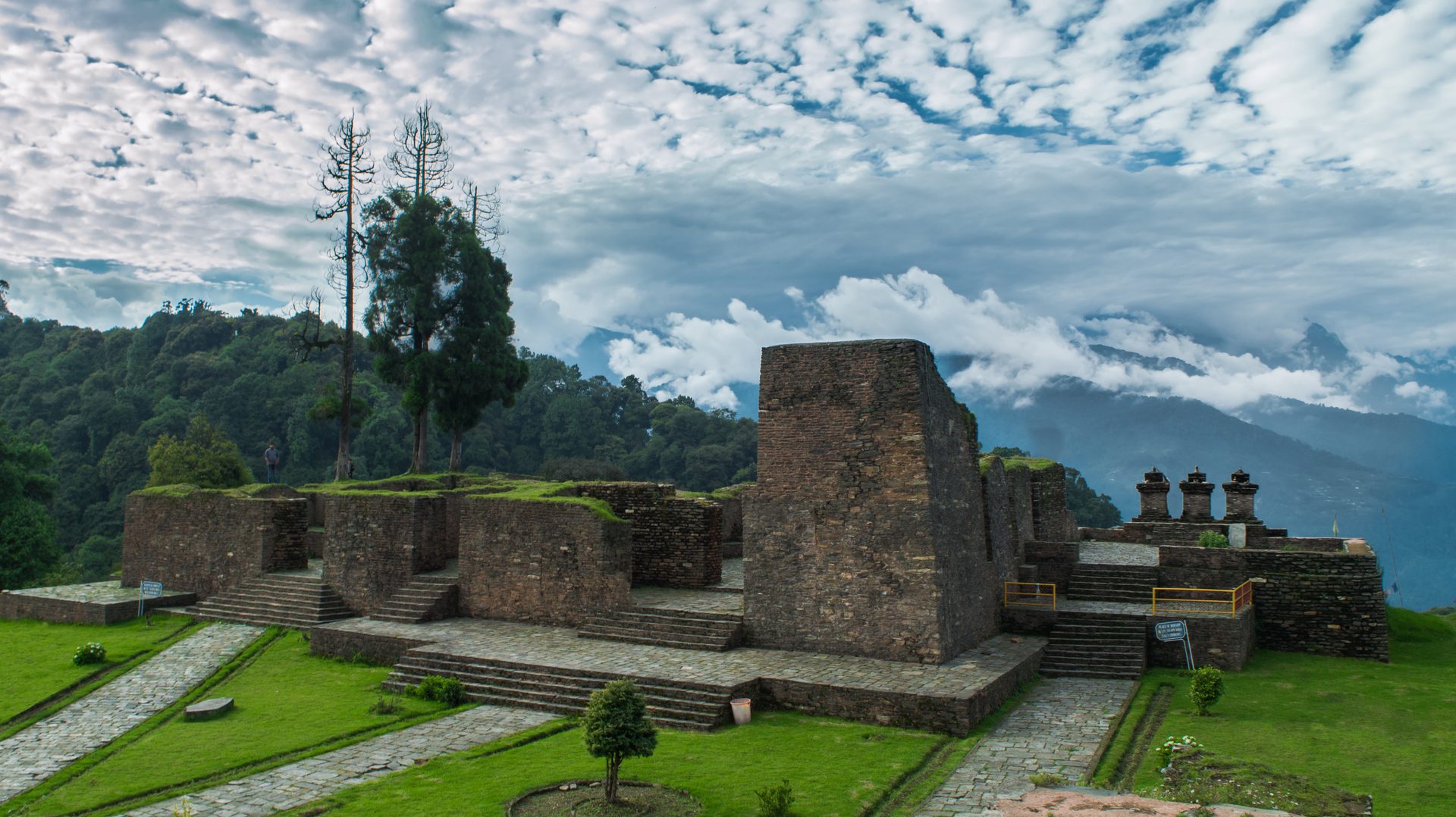
The tiny Himalayan nation of Sikkim had been referred to in Tibetan writings for centuries as the “Valley of Rice” (Drenjong), a “Hidden Land” of the great Buddhist saint, Padmasambhava. Its history can be divided into three phases, corresponding to the institutionalisation of the Buddhist religion:
The early phase which dates from before the 8th Century CE, and revolves around Padmasambhava’s visit to Sikkim en-route to Tibet,
The medieval phase (13th – 17th Centuries) which begins with the establishment of the blood-brotherhood between the Bhutia and Lepcha tribes into a single entity, the arrival of Tertons (revealers of spiritual “treasures”) who established temples, and the consolidation of Sikkim as a kingdom, and
The modern phase which saw the culmination of different tribal groups under the central leadership of the Chogyals, “Dharma rulers” (assisted by the Kazis, a caste of high-ranking political officers) of Sikkim from 1642.
In 1642, the same year as the Fifth Dalai Lama’s installation in Tibet, the first King (“Chogyal”) of Sikkim named Phuntsog Namgyal was installed at Yuksam Norbugang, founding a hereditary princely lineage of Tibetan ancestry. Power over the small original territories was shared with the heads of the native Lepcha and Bhutia families who supplied ministers (including the Kazis) and consorts to the royal court. Three Tibetan lamas conducted the enthronement ceremony, all of whom belonged to the Nyingma sect of Buddhism. They are said to have fled Tibet from Mongol depredations.
Although Sikkim was ruled under the “Chösi Zungdrel” (coordination of religion and state) principle, the Chogyal made no claims to be on par with the Dalai Lamas of Tibet. Instead, he was an initiate and disciple of the Tibetan Nyingmapa Lama Terdag Lingpa, and of Lhatsun Namkha Jigme (“Lhatsun Chenpo”) who performed the Chogyal’s coronation, fulfilling a prediction made by Padmasambhava. By the early 18th Century, Sikkim became an acknowledged client state of Tibet, remaining so even after the British established a Political Officer at Gangtok a hundred years later. This vassal status served as a pretext for China to claim control of Sikkim and to oppose India’s annexation of Sikkim in 1975, which marked the end of the 650 year rule of Sikkim’s Namgyal dynasty.
With the arrival of the East India Company in India, Sikkim allied itself with the British Empire against a common enemy: Nepal’s Gorkha Kingdom. In 1861 the Treaty of Tumlong between Great Britain and Sikkim secured protection for travellers to Sikkim and guaranteed free trade, making Sikkim a de facto British protectorate. Alongside “British Sikkim”, “Independent Sikkim” continued to exist as a rump state cantered around Gangtok. In 1918, Sikkim’s independence in domestic affairs was restored, and retained guarantees of independence from Britain which were transferred to India in 1947. Jawaharlal Nehru agreed to a special protectorate status for Sikkim in which India controlled its external defence, diplomacy and communication. The 11th Chogyal Tashi Namgyal signed a treaty with India giving India suzerainty over Sikkim.
In 1962, India and China went to war. Although Sikkim was an independent country, battles occurred at the Nathu La Pass between Indian and Chinese military. After the war, the ancient pass was shut down until 2006.
After the passing of Tashi Namgyal in 1963 and Nehru in 1964, the mutual agreements of these statesmen faced increasing disregard. Sikkim’s 12th and last Chogyal, Palden Thondup Namgyal, ascended the throne in 1965. Indira Gandhi, who became Prime Minister in 1966, had little patience for maintaining Sikkim’s independence or its monarchy. The new Chogyal was viewed by India as politically dangerous, especially after his wife, the American socialite Hope Cooke, published a journal article advocating a return of certain former Sikkimese properties.
In 1967 China sent its troops to lay claim to Sikkim but were defeated by the Indian Army in the Cho La incident. As a result China withdrew its claim to Sikkim. In 1973 the anti-monarchy Sikkim National Congress Party, demanding greater representation for Nepalese, fomented riots, leading to a formal request for protection from India. Concerned that an unstable Sikkim would invite China to act on its territorial claims, India worked to wrest control of the country away from the Chogyal. As the crisis deepened, the Queen’s foreign background became a major issue and she was forced to flee Sikkim.
By 1974, Sikkim was transformed from a protectorate to an associate state with Kazi Lendup Dorji as its first Chief Minister. The Chogyal was placed under siege, Indian police took control of the streets of Gangtok, and the borders were closed. By 1975, the Sikkimese Chief Minister appealed to India for a change of status to statehood, and a referendum was held. The Chogyal opposed the referendum and the prospect of annexation trying in vain to abdicate power to the elected representatives on the condition that Sikkim should not be merged with India. When he failed, he fled to the U.S., where he would stay until his death of cancer in 1982. On 16 May 1975 Sikkim merged with the union of India, and the monarchy was abolished.
The 1979 assembly election saw Nar Bahadur Bhandari elected Chief Minister of Sikkim. Bhandari held on to win again in 1984 and 1989. In 1994, Sikkim Democratic Front politician Pawan Kumar Chamling became the Chief Minister of Sikkim, consolidating his position over 25 years to become India’s longest serving Chief Minister, until electoral defeat in 2019.
Hope-la in Gangtok, Time (1965-04-16)
Fairy Tale’s End, Time (1975-05-05)
J. C. White, the First British Political Officer of Sikkim, Sikkim History Hunter (2011-03-17)
History of Sikkim, SIBLAC (archive 2012)
The Sikkim saga, through an American lens, The Hindu (2013-04-15)
Smash and Grab: Annexation of Sikkim, Sunanda K. Datta-Ray (2013)
Sikkim: Requiem for a Himalayan Kingdom, Andrew Duff (2015)